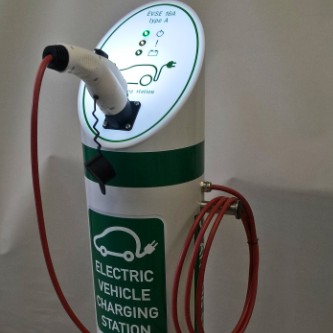TEIWM experimental microgrids and equipment
1) First experimental microgrid
In the microgrid-based smart distribution grid topology, every DC load, generator or energy storage device is equipped with its DC-AC inverter and connected to the AC microgrid via smart devices that are called special control units (SCUs) in this paper. SCUs are also necessary for the AC loads (or group of loads) and AC generators as well, as shown in Fig. 1. The special control units (SCUs) are categorized in load SCUs (L-SCUs), storage SCUs (S-SCUs), generators SCUs (G-SCUs) and interconnection SCUs (I-SCUs), for connecting the small grid of the AC-bus to the remaining grid (SD). All SCUs consist of a simple metering module, a communication module, an activation module (actuator) and a “smart” module that is responsible for the decision making of each SCU. The last module is integrated into software that runs on a microgrid-dedicated PC. This topology is implemented at the facilities of the Technological Educational Institute of West Macedonia (TEIWM) and is shown in Fig. 2.
The microgrid consists of two PV-inverters of 1.1 kW each, with 6 connected PV panels each, five loads of approximately 2600 W maximum consumption, a 600 Ah-24 V battery bank with its inverter and one wind generator of 1 kWp with its rectifier-charger. The entire output power of the wind generator is rectified and channeled to the battery and then the battery power is inverted and channeled to the AC bus. Ten SCUs are needed: Two for the PV plants, five for the loads, one for the battery bank, one for the wind generator and one for the interconnection to the remaining grid. Each SCU contains one current transformer (CT), one voltage transformer (VT), one actuator-relay and communicates with the microgrid-dedicated PC via cables and two Data Acquisition Cards (DAQ: NI6008). However, due to the common AC bus, only one AC VT is needed and one DC VT for the battery bank. All the metering devices are calibrated at the Low frequency Laboratory, Electrical Department of the Hellenic Institute of Metrology. Error in the current measurements is usually taken place if a current transformer with the Hall-effect is used for the measurement of the DC current. However, if a shunt resistance is used, the error maybe eliminated.
At the microgrid-dedicated PC, a software application in Labview processes the input data, incorporates the control algorithm in Matlab and derives the proper output commands every duty-cycle.
2) Secomd experimental microgrid
A new microgrid is connected to the same AC-bus with the existing one. The new microgrid will serve mainly as electric vehicles charging station. Two hydrogen fuel-cell units of 1,2 kW capacity each with their inverters, two electrolysis units and two hydrogen storage canisters, an island inverter (SMA Sunny Island 5048), a 1 kW vertical axis wind-turbine, 10 thin-film PV panels of total capacity 1 kW with their PV-inverter (SB1100), 24 FLA batteries of 323 Ah capacity each, a vertical-axis wind generator of 1,5 kWp, a plug-in Electric vehicle, a scooter and an electric bicycle are already in the possession of TEIWM and are the parts of the new microgrid (http://ape.ee.teiwm.gr/index.php?option=com_content&view=article&id=22&Itemid=161&lang=en). In the framework of the Green E-motion project, the TEIWM has installed in its premises an electricity grid-fed charging station, which was accompanied by an electric vehicle Smart ED.
3) Future plans of the laboratory
The laboratory is one of the first KNX scientific partners in Greece and has already run a research project on interoperability issues between KNX systems and microgrid control systems. Regarding KNX equipment, the laboratory has acquired recently KNX smart meters, KNX ETS 5.0 licenses and numerous KNX devices that form a KNX smart home energy management system.
Therefore, one of the objectives of the laboratory is to apply to the microgrids KNX and other control methods that will operate efficiently and securely together and guarantee reliable power supply.
One additional objective is to manage to incorporate into the microgrid’s control system Intelligent Transportation Systems (ITS) technologies, that will allow EVs to coordinate with the electricity grid and supply ancillary services.
Πατήστε εδώ για περισσότερα.
 |
|
|
|
|
 |
|
 |
||










